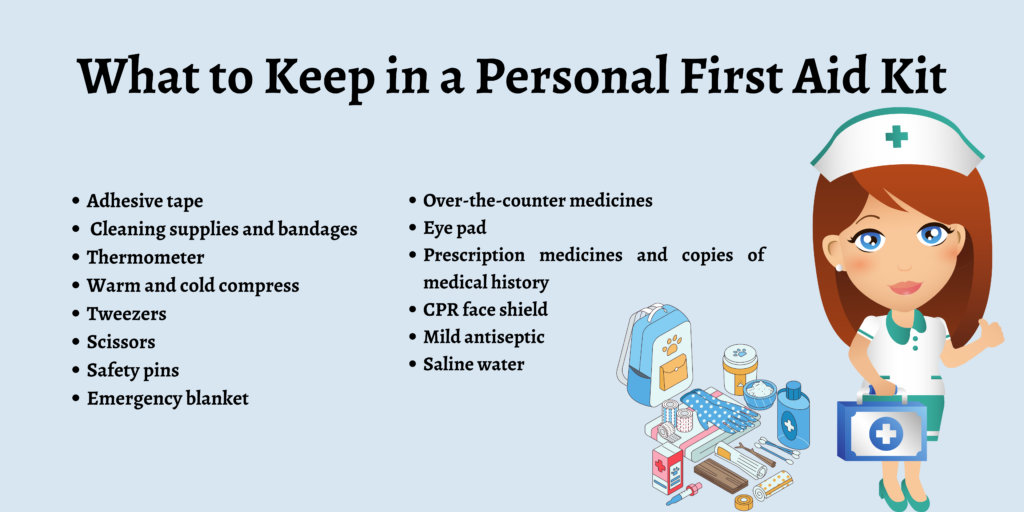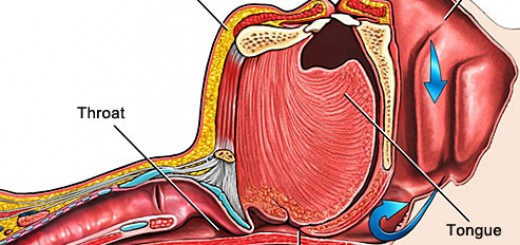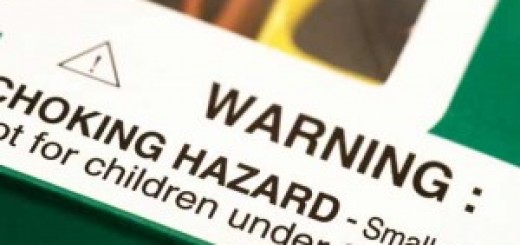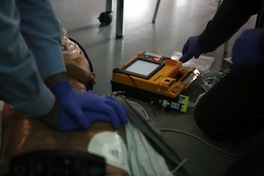Personal First Aid Kit Checklist
Having a first aid kit of your own is extremely essential in cases of emergencies. While having one at home is crucial, you should also keep a backup in your car. Make sure that it has all the necessary items to deal with minor injuries and accidents.
Remember to keep the first aid kit at home in a dry and cool place where the children cannot reach it. If you work in an office environment, it’s a wise idea to keep yourself aware of where the first aid supplies are stored.
What to Keep in a Personal First Aid Kit?
Listed below are some of the crucial items to include in a personal first-aid kit:
- Adhesive tape: Medical adhesive tape can help in attaching bandages and other types of dressings on a victim’s skin around their wounds.
- Cleaning supplies and bandages: The items in your first aid kit should help in treating burns, scrapes, and cuts, among other things. For this purpose, your kit should include the following:
Ø Roller bandages
Ø Gauze pads
Ø Latex gloves
Ø Antiseptic wipes
Ø Bandages of various sizes
- Thermometer: If you want to determine whether you or someone in the family is suffering from a fever or not, the easiest way to do so is by having a thermometer in your first aid kit.
- Warm and cold compress: Warm and cold compresses help in treating stiff joints, inflammation, muscle spasms, swelling, pain, and infections.
- Tweezers: If someone is dealing with splinters, tweezers are needed to safely remove the pieces of glass from the skin to prevent infections.
- Scissors: Scissors are required to remove dressings, cut bandages, and even cut through a victim’s clothes if needed.
- Safety pins: Safety pins can help in securing a bandage over a wound. They aid in keeping the fabric of a victim’s clothing together so as to securely cover any wounds or cuts.
- Emergency blanket: An emergency blanket can help in covering the body of a victim suffering from hypothermia. They are also needed to retain body heat if you live in cold climates or go hiking outdoors and require something to keep yourself warm.
- Over-the-counter medicines: Certain medicines should be present in the first aid kit of every household to treat headaches, stomach issues, muscle pain, and so on. These include cold medication, Ibuprofen, laxatives, etc.
- Eye pad: Eye pads help in covering the eye and protecting it from dust, grime, and other foreign bodies that could cause infections. This is needed if someone’s eye gets injured or wounded.
- Prescription medicines and copies of medical history: You never know when one might have to be rushed to the hospital in emergency situations. In such cases, having a copy of their medical history is imperative. Also, if you take any prescription medicines, keep them stacked well in your kit in the event of any emergencies or disasters, such as cyclones and blizzards.
- CPR face shield: You might find yourself in a situation where you need to perform CPR on a victim. In such cases, a CPR face shield helps in protecting you from any infections.
- Mild antiseptic: A mild antiseptic should definitely be a part of your first aid kit since it prevents cuts and scrapes from getting infected. Something like hydrogen peroxide can also be used to rinse your mouth if you suffer from issues such as gingivitis or cold sores.
- Saline water: Saline water helps in getting rid of irritants from one’s eye, including dirt and debris. It also aids in cleaning wounds and washing and rinsing other parts of the body.
FAQs
1. What is a first aid kit?
A first aid is a container or box that includes items one would need in cases of medical emergencies.
2. What are some of the things to have in a first aid kit?
Some of the things to have in a first aid kit include bandages, antiseptic wipes, saline water, eye pads, safety pins, tweezers, scissors, and adhesive tapes.
3. Should I keep a cold compress in my first aid kit?
Yes, you should definitely keep a cold compress in your first aid kit, as it helps in reducing pain and inflammation.
4. Why should there be a blanket in a first aid kit?
Blankets help in covering the body of victims in emergency situations and are required if someone is suffering from hypothermia.
Conclusion
One can easily buy a pre-assembled first aid kit at a pharmacy, or you can make one of your own. There are also different kits you can keep for different purposes, such as for traveling or when you go hiking, boating, and so on.
Regardless of how many first aid kits you have, ensure to tailor it as per your needs and requirements, also keeping in mind what your children and other family members may need during emergency situations.
Recommended first aid kits
Our team has reviewed and handpicked the best personal small first aid kits available. Here are the top picks:
Do you carry other items in your first aid kit? Let us know in the comments section.










Great and essential topic.